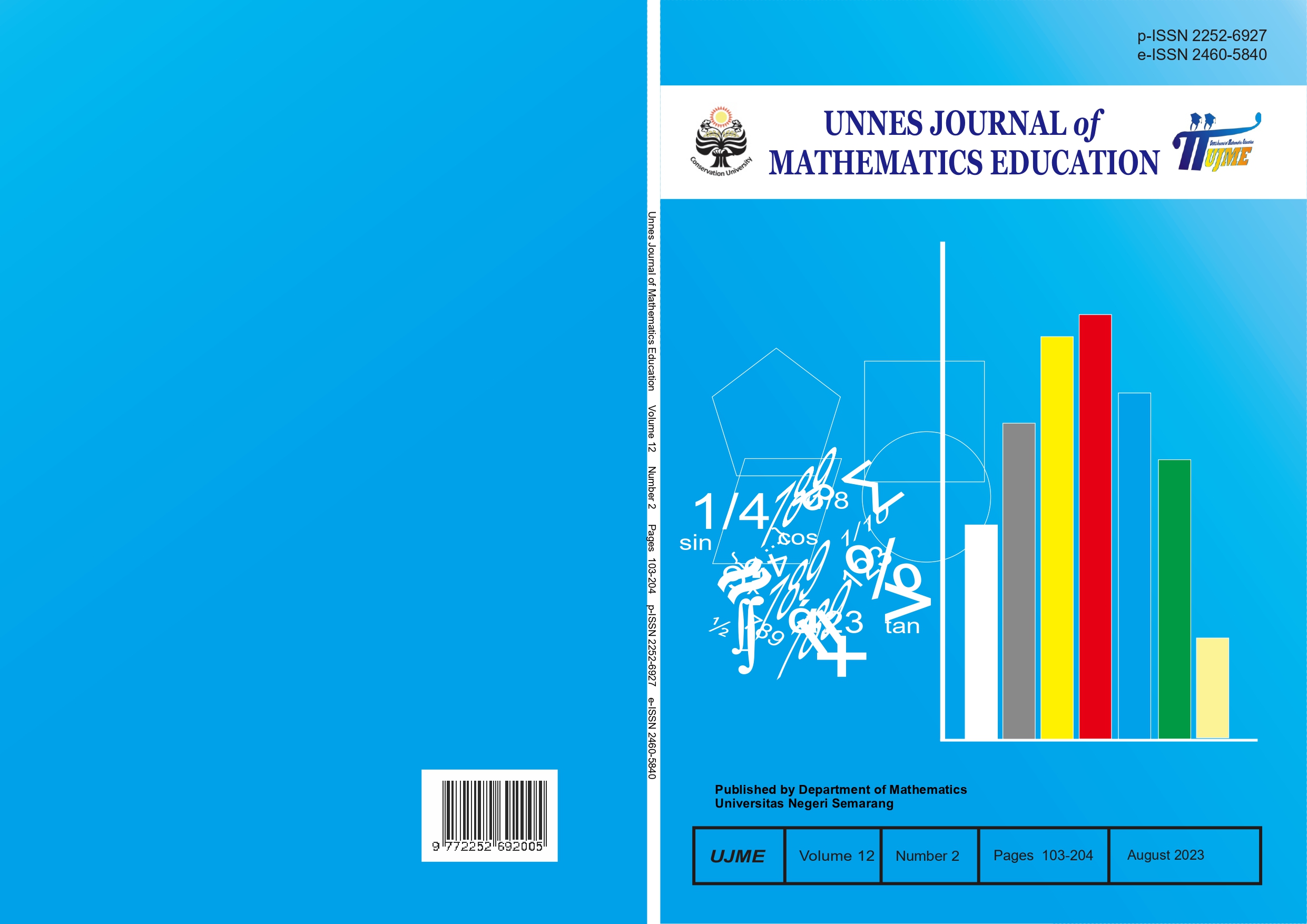Classification of figures in primary school based on van Hiele’s model: Report of two cases
##plugins.themes.academic_pro.article.main##
Abstract
In this paper, the results of an investigation based on an activity on the recognition of geometric shapes are reported, where different figures were presented that must be classified in order to identify the level of reasoning of each student. The present investigation follows a qualitative method and the data collection was carried out through clinical interviews applied to two children, an 8-year-old boy and a 10-year-old girl, who at that time were in the third and fourth grades of primary school respectively, in the State of Puebla, Mexico. Among the main results, it stands out that both children were located at level 0 of reasoning according to van Hiele's classification, since they recognize geometric shapes by their physical appearance, not by their properties and relationships.
##plugins.themes.academic_pro.article.details##
References
Barrantes, L. M., & Zapata, E. M. A. (2015). Obstáculos y errores en la enseñanza-aprendizaje de las figuras geométricas. Campo Abierto. Revista de Educación [en línea], 27(1), 55-71. https://relatec.unex.es/revistas/index.php/campoabierto/article/view/1985
Clements, D. H. (2003). Teaching and learning geometry. In J. Kilpatrick, W. G. Martin, y D. Schifter (Eds.), A research companion to principles and standards for School mathematics, (pp. 15-78). Reston, VA: National Council of Teachers of Mathematics.
Crowley, M. L. (1987). The van Hiele Model of the Development of Geometric Thought. En M. Montgomery (Ed.), Learning and Teaching Geometry, K-12. Yearbook of the National Council of Teachers of Mathematics, (pp.1-16). Reston, Va.: National Council of Teachers of Mathematics.
Duranovic, M., & Didic, E. (2023). Prevalence and characteristics of geometric difficulties in elementary school children. Asia Pacific Journal of Developmental Differences, 10(1), 5-26.
FengSer, P., Shaharom, M. S. N. B., Bajuri, M. R. B., & Chan, C. T. (2022). Pedagogical Strategies Using Van Hiele’s Levels of Geometric Thinking in Learning Geometry Among Malaysian Year Five Students. Educational Leader (Pemimpin Pendidikan), 10, 13-29
Fuys, D., Geddes, D. & Tischler, R. (1988). The van Hiele Model of Thinking in Geometry among Adolescents. Journal for Research in Mathematics Education. Monograph, Vol. 3, The van Hiele Model of Thinking in Geometry among Adolescents, pp. i+1-196 Published by: National Council of Teachers of Mathematics Stable. http://www.jstor.org/stable/749957
Ginsburg, H. P. (1997). Entering the child’s mind. The clinical interview in psychological research and practice. Cambridge University Press.
Godino, J. & Ruiz, F. (2002). Geometría y su Didáctica para Maestros. Manual para el Estudiante. Universidad de Granada.
Gutiérrez, A. & Jaime, A. (1996). Uso de definiciones e imágenes de conceptos geométricos por los estudiantes de Magisterio. En J. Giménez, S. Llinares, y M. V. Sánchez (Eds.). El proceso de llegar a ser un profesor de Primaria. Cuestiones desde la educación matemática. (pp. 145-169). Granada: Comares.
Hernández-Sampieri, R. & Mendoza, C. (2018). Metodología de la investigación. McGraw-Hill Interamericana.
Levenson, E., Tirosh, D., & Tsamir, P. (2011). Preschool Geometry. Sense Publishers.
Md. Yunus, A. S., Mohd Ayub, A. F., & Hock, T. T. (2019). Geometric Thinking of Malaysian Elementary School Students. International Journal of Instruction, 12(1), 1095-1112.
Secretaría de Educación Pública (2017). Aprendizajes claves para la educación integral, plan y programas para la educación básica. Ciudad de México, México: Autor.
Valencia, P. (2018). Visualización geométrica en niños de enseñanza elemental. Acta Latinoamericana de Matemática Educativa, 31(1), 490-496.
van Hiele, P. M. (1984). The child’s through and geometry. En D. Fuys, D. Geddes, y R. Tischler (Eds.), English translation of selected writings of Dina van Hiele-Geldof and Pierre M. van Hiele (pp. 243-252). Brooklyn, NY: Brooklyn College, School of Education. https://files.eric.ed.gov/fulltext/ED287697.pdf.
van Hiele-Geldof, D. (1984). The didactics of geometry in the lowest class of secondary school. En D. Fuys, D. Geddes, y R. Tischler (Eds.), English translation of selected writings of Dina van Hiele-Geldof and Pierre M. van Hiele (pp. 1-214). Brooklyn, NY: Brooklyn College, School of Education. https://files.eric.ed.gov/fulltext/ED287697.pdf.
Vinner, S. & Hershkowitz, R. (1983). On concept formation in geometry. Zentralblatt für Didaktik der Mathematik, 83(1), 20-25.
Yi, M., Flores, R., &Wang, J. (2020). Examining the influence of van Hiele theory-based instructional activities on elementary preservice teachers’ geometry knowledge for teaching 2-D shapes. Teaching and Teacher Education, 91, 103038. https://doi.org/10.1016/j.tate.2020.103038.
Wu, D. B., Lee, D. C., Lin, S. H., & Ma, H. L (2015). A study of van Hiele of geometric thinking among 1 st through 6th graders. Eurasia Journal of Mathematics, Science and Technology Education, 11(5), 1181-1196. https://doi.org/10.12973/eurasia.2015.1412a
